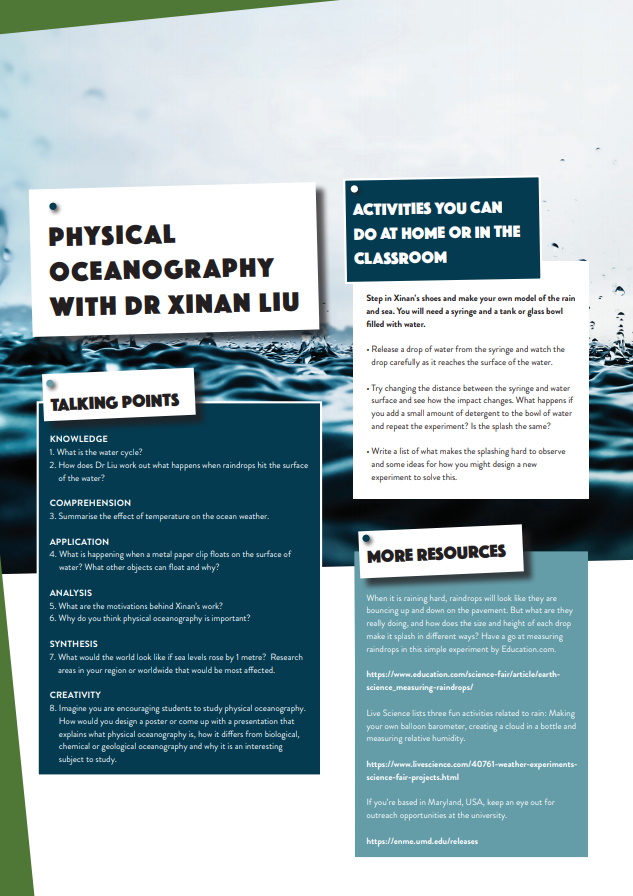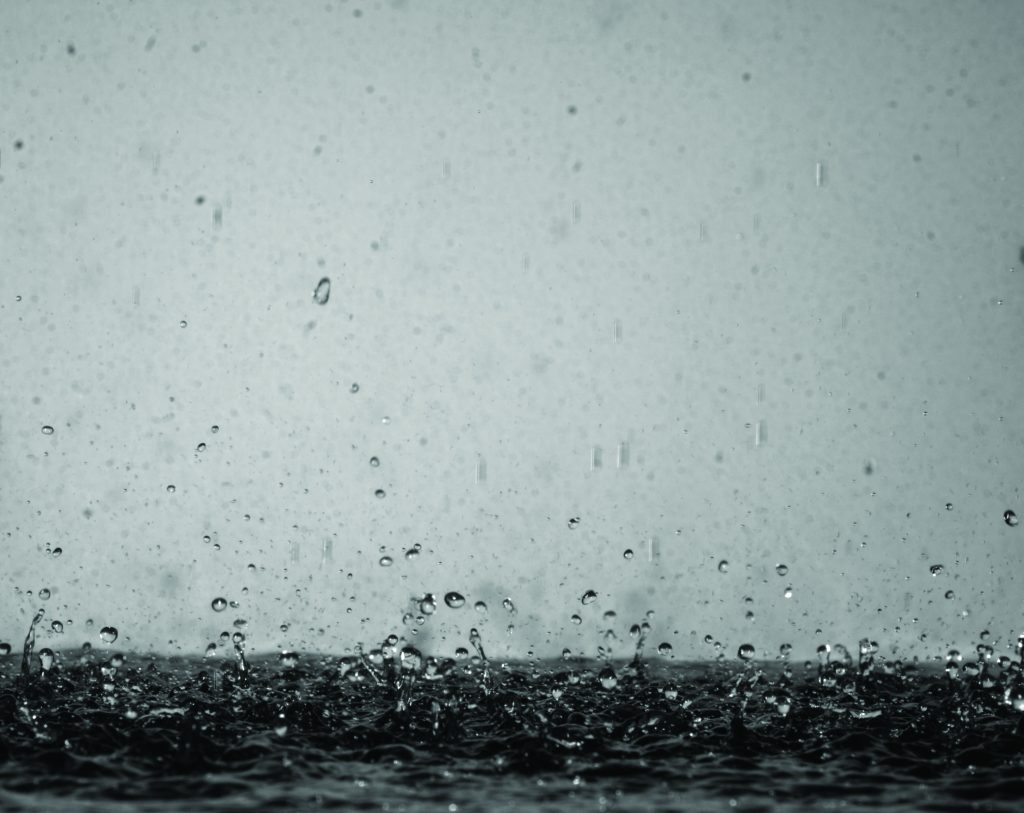What if raindrops could help us understand climate change?
A raindrop falling onto the ocean seems like a simple event, but behind this, there is an incredibly complex sequence of physical processes. Dr Xinan Liu of the University of Maryland, USA, uses advanced techniques to film raindrops. His aim is to understand the physics and how the small act of rain falling onto water contributes to our global climate
TALK LIKE A PHYSICAL OCEANOGRAPHER
PHYSICAL OCEANOGRAPHY – the study of physical processes and conditions in the ocean
AIR-SEA BOUNDARY LAYER – the area where the air and ocean meet; between the two, water and air exchanges occur
EVAPORATION – when a liquid becomes a gas
DROPLETS – small drops of water that are present in the air
SURFACE TENSION – The property of the surface of a liquid that allows it to resist an external force, due to the cohesive nature of its molecules. This is why a paper clip made of steel can float.
MODELLING – using physics equations to predict and understand the behaviour of systems such as rainstorms
The ocean covers 70 per cent of the world’s surface and holds 97 per cent of the world’s water. This vast expanse of water plays a key role in our planet’s climate and local weather conditions. Indeed, water evaporating from the ocean surface, and ending up as rainfall on land or back on the ocean, is part of an endless process of change known as the water cycle. Ocean currents – continuous, directed movements of sea water around the globe – are also vital for distributing heat energy, regulating weather and climate, and cycling nutrients and gases.
Dr Xinan Liu is fascinated by the ocean and understanding how it interacts with rain. He researches the air-sea boundary layer, which is where the rain meets the ocean. The air-sea boundary layer is one of the ways the ocean plays an important role in our climate, but we know surprisingly little about the physics behind the raindrops that fall in it.
Understanding how raindrops fall and splash on the ocean surface is important for predicting how much moisture will be in the air at the air-sea boundary layer. It is also important for working out how weather conditions, like wind, can change the evaporation processes happening at sea.
RAINDROPS
When raindrops fall on the surface of the ocean, they make splashes and ripples, just as you would see if you watched the rain falling on a puddle. The challenge for Xinan is to find the right equations and physics to describe these events, including the processes we cannot see. Xinan uses high-speed cameras to capture the movements of water on the ocean surface that are too fast for the naked eye. By studying these images, Xinan has shown that when a raindrop hits the ocean, a thin sheet of water is thrown up in all directions. This water sheet is unstable, meaning that thin jets of water form on the top surface and the resulting splash looks like a crown.
The crown then breaks up and ejects droplets of various sizes. While these droplets are forming, a central water column or ‘stalk’ rises from the point at which the raindrop hits the surface of the ocean and ripples start to take shape.
Given that so many different events happen when a raindrop falls on the water surface, Xinan uses varying photographic techniques. For some experiments in the lab, he adds fluorescent dyes to water tanks to track the movement of the water surface. At sea, he uses radar systems to map the shapes formed by the stalks. And, at an even larger scale,
Xinan and his team make use of satellite-based radar imagery. “With sophisticated radar instruments employed in satellites, we can look at rain cells – the area within which it is raining – and storms in three-dimensions and observe how rain and snow vary with time over both land and oceans around the world,” says Xinan.
Interestingly, how the rain behaves when it hits the ocean surface varies considerably. Xinan wants to understand the physics behind these events and how they are affected by environmental conditions like windspeed and temperature.
WARMING EFFECTS
When air becomes warmer, it can hold more water. This means the atmosphere becomes moister, particularly over the ocean. Higher temperatures lead to more water evaporation and, combined with greater moisture levels, this means more rain, snow and intense rainstorms.
Xinan has discovered that the surface tension and wind speed across the ocean surface affect how raindrops fall and their contribution to the air-sea boundary layer. Being able to describe the physics involved will enable scientists to monitor ocean weather more effectively and predict how our planet’s climate is changing.
The data Xinan collects are used to improve modelling and therefore our understanding of how water is transferred between the air and the sea.
“I develop and test techniques to measure micro-scale phenomena generated by the impact of raindrops on the ocean,” explains Xinan. “This research is important because large scale motions in the atmosphere and ocean are determined by these micro-scale phenomena”.
 DR XINAN LIU
DR XINAN LIU
Research Professor
University of Maryland, USA
FIELD OF RESEARCH: Physical Oceanography and Fluid Mechanics
RESEARCH PROJECT: Understanding the air-sea boundary layer and its effects on our climate
FUNDER: National Science Foundation
ABOUT PHYSICAL OCEANOGRAPHY
Physical oceanography is about understanding the patterns of how oceans move. It is closely related to fluid dynamics, which is an area of physics and engineering that seeks to understand how liquids and other fluids move and flow. Oceanography can cover everything from monitoring the effect of polar sea ice on ocean currents to looking at how and why big waves form during storms.
Reference
https://doi.org/10.33424/FUTURUM120
PHYSICAL OCEANOGRAPHY – the study of physical processes and conditions in the ocean
AIR-SEA BOUNDARY LAYER – the area where the air and ocean meet; between the two, water and air exchanges occur
EVAPORATION – when a liquid becomes a gas
DROPLETS – small drops of water that are present in the air
SURFACE TENSION – The property of the surface of a liquid that allows it to resist an external force, due to the cohesive nature of its molecules. This is why a paper clip made of steel can float.
MODELLING – using physics equations to predict and understand the behaviour of systems such as rainstorms
The ocean covers 70 per cent of the world’s surface and holds 97 per cent of the world’s water. This vast expanse of water plays a key role in our planet’s climate and local weather conditions. Indeed, water evaporating from the ocean surface, and ending up as rainfall on land or back on the ocean, is part of an endless process of change known as the water cycle. Ocean currents – continuous, directed movements of sea water around the globe – are also vital for distributing heat energy, regulating weather and climate, and cycling nutrients and gases.
Dr Xinan Liu is fascinated by the ocean and understanding how it interacts with rain. He researches the air-sea boundary layer, which is where the rain meets the ocean. The air-sea boundary layer is one of the ways the ocean plays an important role in our climate, but we know surprisingly little about the physics behind the raindrops that fall in it.
Understanding how raindrops fall and splash on the ocean surface is important for predicting how much moisture will be in the air at the air-sea boundary layer. It is also important for working out how weather conditions, like wind, can change the evaporation processes happening at sea.
RAINDROPS
When raindrops fall on the surface of the ocean, they make splashes and ripples, just as you would see if you watched the rain falling on a puddle. The challenge for Xinan is to find the right equations and physics to describe these events, including the processes we cannot see. Xinan uses high-speed cameras to capture the movements of water on the ocean surface that are too fast for the naked eye. By studying these images, Xinan has shown that when a raindrop hits the ocean, a thin sheet of water is thrown up in all directions. This water sheet is unstable, meaning that thin jets of water form on the top surface and the resulting splash looks like a crown.
The crown then breaks up and ejects droplets of various sizes. While these droplets are forming, a central water column or ‘stalk’ rises from the point at which the raindrop hits the surface of the ocean and ripples start to take shape.
Given that so many different events happen when a raindrop falls on the water surface, Xinan uses varying photographic techniques. For some experiments in the lab, he adds fluorescent dyes to water tanks to track the movement of the water surface. At sea, he uses radar systems to map the shapes formed by the stalks. And, at an even larger scale,
Xinan and his team make use of satellite-based radar imagery. “With sophisticated radar instruments employed in satellites, we can look at rain cells – the area within which it is raining – and storms in three-dimensions and observe how rain and snow vary with time over both land and oceans around the world,” says Xinan.
Interestingly, how the rain behaves when it hits the ocean surface varies considerably. Xinan wants to understand the physics behind these events and how they are affected by environmental conditions like windspeed and temperature.
WARMING EFFECTS
When air becomes warmer, it can hold more water. This means the atmosphere becomes moister, particularly over the ocean. Higher temperatures lead to more water evaporation and, combined with greater moisture levels, this means more rain, snow and intense rainstorms.
Xinan has discovered that the surface tension and wind speed across the ocean surface affect how raindrops fall and their contribution to the air-sea boundary layer. Being able to describe the physics involved will enable scientists to monitor ocean weather more effectively and predict how our planet’s climate is changing.
The data Xinan collects are used to improve modelling and therefore our understanding of how water is transferred between the air and the sea.
“I develop and test techniques to measure micro-scale phenomena generated by the impact of raindrops on the ocean,” explains Xinan. “This research is important because large scale motions in the atmosphere and ocean are determined by these micro-scale phenomena”.
 DR XINAN LIU
DR XINAN LIU
Research Professor
University of Maryland, USA
FIELD OF RESEARCH: Physical Oceanography and Fluid Mechanics
RESEARCH PROJECT: Understanding the air-sea boundary layer and its effects on our climate
FUNDER: National Science Foundation
ABOUT PHYSICAL OCEANOGRAPHY
Physical oceanography is about understanding the patterns of how oceans move. It is closely related to fluid dynamics, which is an area of physics and engineering that seeks to understand how liquids and other fluids move and flow. Oceanography can cover everything from monitoring the effect of polar sea ice on ocean currents to looking at how and why big waves form during storms.
Work in physical oceanography involves a mixture of theory, observation and simulation. For example, some oceanographers go out to sea to take measurements of ocean temperatures in a given region and monitor how they change with time. This data can then be incorporated into models and simulations. When combined with the physics of the ocean’s behaviour, these models and simulations can be used to predict events and monitor changes.
Research in physical oceanography is very important because the ocean plays a critical role in the Earth’s climate as well as sustaining life. Ocean acidification and rising sea levels are two areas of change related to our oceans that many scientists are concerned about and therefore working to better understand.
CAREER OPPORTUNITIES IN PHYSICAL OCEANOGRAPHY
“Careers in physical oceanography are not as popular as mechanical engineering, but far from impossible to find,” says Xinan. “If you prepare well, and with a bit of luck, your dream of working in this field can come true. Many other career opportunities related to physical oceanography are also on the rise. For instance, as more satellites are launched into orbit, scientific programmers will be required to analyse and manage satellite data.”
All in all, studying physical oceanography opens up many exciting routes to either working in a laboratory setting or out in the field, on boats, exploring the oceans. Given how important our oceans are to all life on Earth, physical oceanographers are vital to helping us understand how oceans behave and move. And, as climate change increasingly impacts our seas, physical oceanographers will be key to helping us understand how the changes in the ocean will affect all our lives.
HOW TO BECOME A PHYSICAL OCEANOGRAPHER
• Contact local universities or research centres to see if you are able to get relevant work experience. For example, under normal circumstances, when there are no lockdowns and a global pandemic, the Hydrodynamics Lab at the University of Maryland welcomes high school students. “We can provide a half-hour tour for individuals or a group of high-school students, demonstrating our rain and wave facilities and answering their questions,” says Xinan. “In the summer, we offer several internships and work experience opportunities for high school and college students, including financial support. The students can conduct their own experiments using the facilities in our lab or work with our graduate students on ongoing research projects.”
• The National Oceanography Centre has many resources on their website about what it is like to be an oceanographer and news about jobs and research: https://www.noc.ac.uk/careers
• The average salary in the US for an oceanographer is $70.251
There are a number of routes into oceanography. Most people have at least a bachelor’s degree in either oceanography or a related subject.
For physical oceanography, related subjects would include mathematics, physics, engineering or ocean science.
As many oceanography jobs involve research, a relevant master’s and PhD may be useful. Strong mathematical and data analysis skills are also beneficial, as well as any research experience.
HOW DID XINAN BECOME A PHYSICAL OCEANOGRAPHER?
WHAT DID YOU WANT TO BE WHEN YOU WERE YOUNGER?
Once, I was interested in becoming a middle or high school teacher because I believe education can improve people’s lives and teaching was one of my favourite jobs. However, while I was learning, I decided to follow my interests and prepare myself for whatever lay ahead, instead of a particular career path. I did well in maths and science but also spent a lot of time reading books about different subjects, doing things outside the classroom and practising all kinds of technical and social skills. I followed my curiosity and developed my education through serendipity, which is how I became a physical oceanographer.
WHAT DREW YOU TO STUDYING RAINFALL?
A number of years after I finished my PhD, one of my colleagues, who is a scientist in the field of physical oceanography and remote sensing, started a conversation about seeing the phenomena of rainfall over the ocean in satellite images. Fascinated by those images, I wanted to find out more about rainfall over the ocean. So, I started to design laboratory experiments to simulate the impact of raindrops on the ocean surface and explore the physics of the interaction between raindrops and water surface.
YOU WORK IN THE DEPARTMENT OF MECHANICAL ENGINEERING. IS YOUR BACKGROUND IN MECHANICAL ENGINEERING OR OCEANOGRAPHY?
My educational background is interdisciplinary. I have a BS degree in mathematics, an MS degree in physical oceanography and my PhD is in mechanical engineering, with a major in fluid mechanics.
WHAT DO YOU LOVE MOST ABOUT THE WORK YOU DO?
My work has provided me with the opportunity to explore things no one has ever seen before. I have made new friends around the world from different cultures and multiple research fields. Nowadays, observations of many interesting phenomena in nature heavily depend on instruments and techniques, which people in mechanical engineering develop and make. I love to learn about and apply the latest technologies in my research, and I especially enjoy working in the lab.
HOW OFTEN DO YOU GET TO TRAVEL IN A BOAT OUT TO SEA? OR DO YOU WORK MAINLY IN A LAB?
I travelled in various vessels out to sea many years ago when I worked in an institute of oceanography. Now, I mainly work in lab.
XINAN’S TOP TIPS
01 Prepare for your professional career. Being better prepared means having more practice. The more practice you have, the better the jobs you will have in the future. I am a strong believer in luck coming with hard work.
02 Be persistent in your learning. Maths and science courses can sometimes be challenging, but they are well worth the effort to set you on a path of success.
03 Be proactive in identifying potential problems when you talk and listen to people from different disciplines and backgrounds. You may contribute to solutions to the challenges they face.
Write it in the comments box below and Xinan will get back to you. (Remember, researchers are very busy people, so you may have to wait a few days.)










